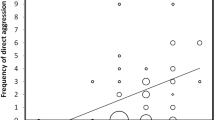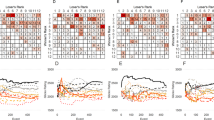Summary
-
1.
Dominant and subordinate male house mice (Mus musculus) were examined for differences in ability to induce a pregnancy block (Bruce effect) in recently inseminated female conspecifics.
-
2.
A male became behaviorally dominant or subordinate by one or two daily 15-min agonistic encounters with one other male for 5 months. Social status was monitored by the outcome of daily fighting, urine-marking patterns, and the ability of the animals' urine to increase uterine weights in prepubertal females. Clear differences were found in all these parameters during the experiments. When killed, dominant males had larger testes, preputials, and seminal vesicles. Adrenal glands were significantly heavier in subordinates.
-
3.
Subordinates blocked pregnancies as effectively as both dominants and control males with no previous agonistic social experience.
Similar content being viewed by others
References
Bellringer JF, Pratt HPM, Keverne EB (1980) Involvement of the vomeronasal organ and prolactin in pheromonal induction of delayed implantation in mice. J Reprod Fertil 59:223–228
Bloch S, Wyss HI (1973) An anti-androgen (cyproterone acetate) inhibits the pregnancy block in mice caused by the presence of strange males (Bruce-effect). J Endocrinol 59:365–366
Bronson FH (1976) Urine marking in mice: Causes and effects. In: Doty RL (ed) Mammalian olfaction, reproductive processes, and behavior. Academic Press, New York, pp 119–141
Bronson FH (1979) The reproductive ecology of the house mouse. Q Rev Biol 54:265–299
Bronson FH, Eleftheriou BE (1964) Chronic physiological effects of fighting in mice. Gen Comp Endocrinol 4:9–14
Bruce HM (1960) A block to pregnancy in the mouse caused by proximity of strange males. J Reprod Fertil 1:96–103
Bruce HM (1961) An olfactory block to pregnancy in mice. Part 1: Characteristics of the block. Proc. IVth Int Congr Anim Reprod, The Hague, pp 159–162
Bruce HM (1967) Effects of olfactory stimuli on reproduction in mammals. CIBA Found. Study Group (paper) 26:29–42
Bruning JL, Kintz BL (1977) Computational handbook of statistics, 2nd ed. Scott, Foresman and Co, Glenview, IL
Buhl AE, Hasler JF, Tyler MC, Goldberg N, Banks EM (1978) The effects of social rank on reproductive indices in groups of male collared lemmings (Dicrostonyx groenlandicus). Biol Reprod 18:317–324
Caroom D, Bronson FH (1971) Responsiveness of female mice to preputial attractant: Effects of sexual experience and ovarian hormones. Physiol Behav 7:659–662
Carr WJ, Martorano RD, Krames L (1970) Responses of mice to odors associated with stress. J Comp Physiol Psychol 71:223–228
Chipman RK, Fox KA, (1966) Factors in pregnancy blocking: Age and reproductive background of females: Number of strange males. J Reprod Fertil 12:399–403
Daly M, Wilson M (1978) Sex, evolution, and behavior: Adaptations for reproduction. Duxbury, North Scituate, MA
Dawkins R (1976) The selfish gene. Oxford University Press, New York
Desjardins C, Maruniak JA, Bronson FH (1973) Social rank in house mice: Differentiation revealed by ultraviolet visualization of urinary marking patterns. Science 182:939–941
Dewsbury DA (1978) Comparative animal behavior. McGraw-Hill, New York
Dominic CJ (1965) The origin of the pheromones causing pregnancy block in mice. J Reprod Fertil 10:469–472
Hoppe PC (1975) Genetic and endocrine studies of the pregnancy-blocking pheromone of mice. J Reprod Fertil 45:109–115
Krames L, Carr WJ, Bergman B (1969) A pheromone associated with social dominance among male rats. Psychon Sci 16:11–12
Labov JB (1980) Factors influencing infanticidal behavior in wild male house mice (Mus musculus). Behav Ecol Sociobiol 6:297–303
Labov JB (in press) Pregnancy blocking in rodents: Adaptive advantages for females. Am Nat
Lombardi JR, Vandenbergh JG (1977) Pheromonally induced sexual maturation in females: Regulation of the social environment of the male. Science 196:545–546
Mallory FF, Brooks RJ (1978) Infanticide and other reproductive strategies in the collared lemming, Dicrostonyx groenlandicus. Nature 273:144–146
McKinney TD, Desjardins C (1973) Intermale stimuli and testicular function in adult and immature house mice. Biol Reprod 9:370–378
Rogers JG, Beauchamp GK (1976) Some ecological implications of primer chemical stimuli in rodents. In: Doty RL (ed) Mammalian olfaction, reproductive processes, and behavior. Academic Press, New York, pp 181–195
Schwagmeyer PL (1979) The Bruce effect: An evaluation of male/female advantages. Am Nat 114:932–938
Scott JW, Pfaff DW (1970) Behavioral and electrophysiological responses of female mice to male urine odors. Physiol Behav 5:407–411
Vandenbergh JG, Whitsett JM, Lombardi JR (1975) Partial isolation of a pheromone accelerating puberty in female mice. J Reprod Fertil 43:515–523
Wilson EO (1975) Sociobiology, the new synthesis. Harvard Belknap, Cambridge, MA
Author information
Authors and Affiliations
Rights and permissions
About this article
Cite this article
Labov, J.B. Male social status, physiology, and ability to block pregnancies in female house mice (Mus musculus). Behav Ecol Sociobiol 8, 287–291 (1981). https://doi.org/10.1007/BF00299528
Received:
Accepted:
Issue Date:
DOI: https://doi.org/10.1007/BF00299528




